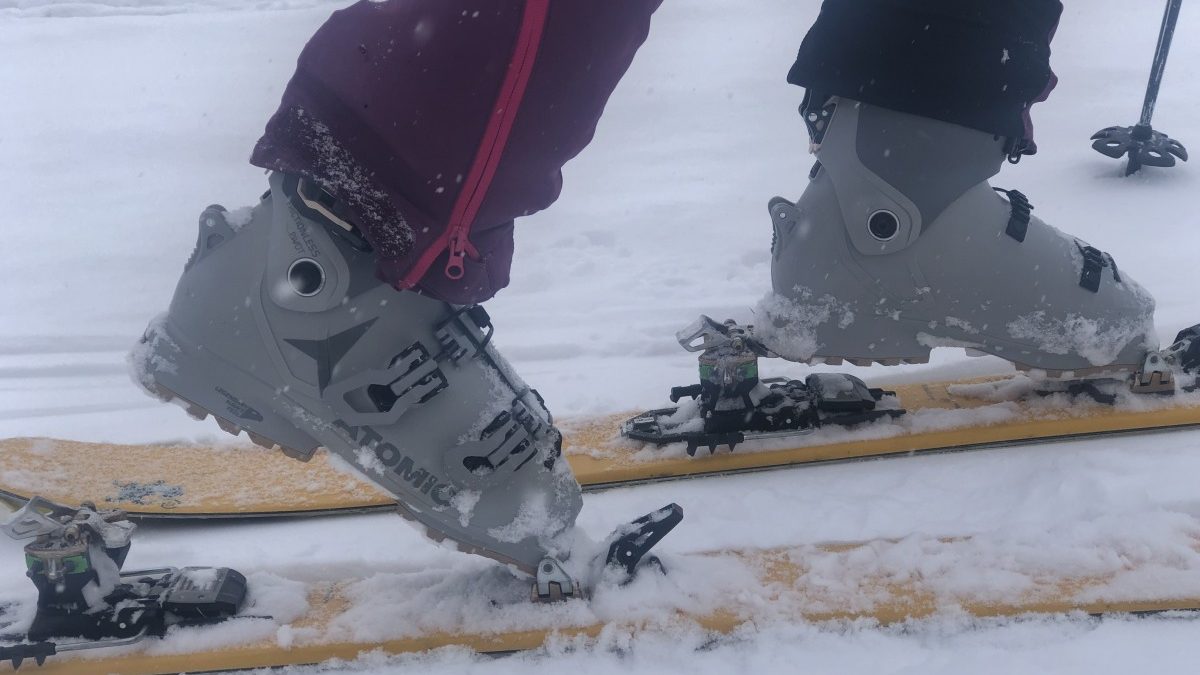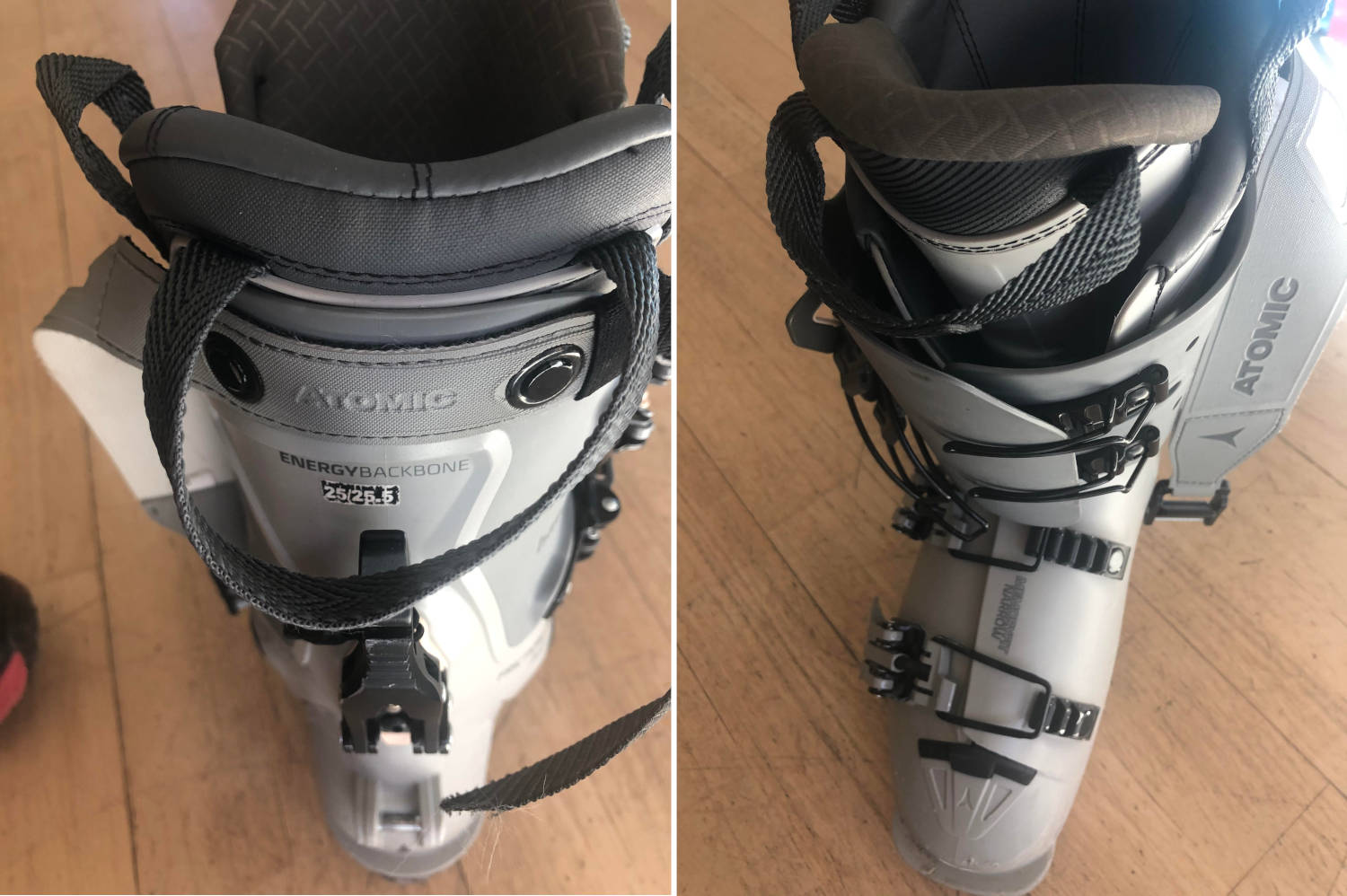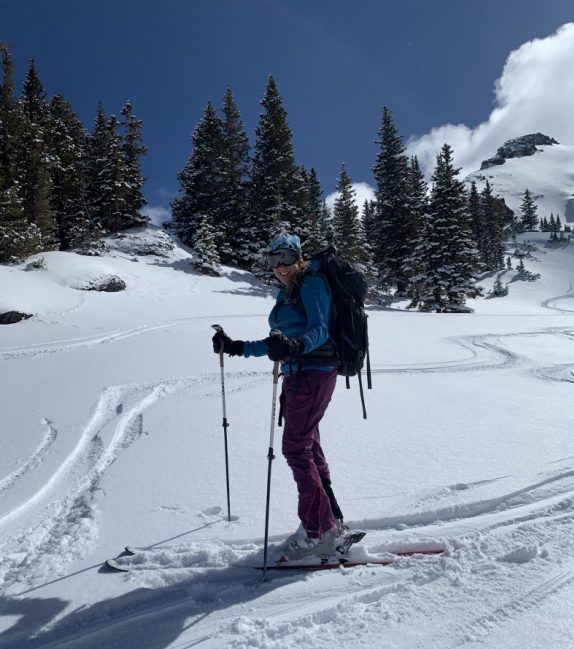
The Atomic Hawx Ultra XTD 115 W Tech touring boot is a suitable option for narrow-footed women who seek a balance of downhill and uphill performance, with slightly more emphasis on the downhill.
Hope springs eternal in backcountry ski touring, for powder days, for epic runs, for snow stability—and for a boot that performs just the way you want it to on both the uphill and the down. In my ongoing quest for just such a boot, I’ve been using Atomic’s Hawx Ultra XTD 115 W Tech GW for the past three and a half months. Spoiler alert: it excels on the downhill. That means I’ve been very happy with it for at least 50 percent of the time, and often much more.
Falling between Atomic’s standard alpine boots and the brand’s lightweight, touring-specific Backland series, the Hawx Ultra XTD family aims to fill the gap by enabling solid downhill performance with enough range of motion and weight savings to competently tour. At $700, the 115 W Tech is right in line pricewise with other women’s AT boots.
When I first opened the box, my heart sank just a bit as I noticed the boot’s traditional overlap, four-buckle construction. Not only was it not what I expected for an AT boot, but up to then I’d only toured in boots with three-piece tongue construction. I feared the Hawx Ultra XTD would be heavy and cumbersome for skinning. But when I lifted one up, I realized it was about as light as the Scarpa Geas I’d skied in for the past several years, and way lighter than my alpine boots. (A pair of the Hawx Ultra XTD weighs in at 1,360 grams (size 24.5); for comparison, current-model Geas are 1,250 grams (size 25), and my older ones are a tad heavier.) Hope restored.
Features
With a 98mm last and relatively low volume, the Hawx Ultra XTD is a good choice for my narrow feet. ((For those with wider feet, Atomic offers the Hawx Prime XTD 115 W Tech GW, with a 100mm last.) I usually wear a 24.5 in ski boots (and often sacrifice a couple of toenails each ski season) but I’ve been using the Hawx’s test size of 25/25.5 with little to no problem—and no lost toenails.
Heat-moldable material in the heel, ankle, and tongue areas allows the fit to be fine-tuned, which was an update for this winter’s boot and could be a big selling point for many; the Hawx Ultra XTD’s shell (including the cuff) can also be heat molded to fit, too. Since I didn’t know how long I’d be skiing in this pair of test boots—and I tend to err on the side of minimalism when it comes to gear adjustments—I didn’t go through the heating process. I did insert my own custom footbeds. It certainly helped that the boots fit fairly well out of the box, and I didn’t experience any blisters or tight spots during use.

The Atomic Hawx Ultra XTD 115 W offers many custom fit features including a heat moldable shell and cuff.
The Hawx Ultra XTDs have tech binding inserts and GripWalk soles, and are compatible with both touring and standard alpine bindings. For most of the season, I’ve paired these boots with my very light DPS Wailers (168 cm long, 139/112/124) mounted with Dynafit Radical bindings. For several weeks, I also used them with a slightly heavier touring set-up, a pair of 2021-22 Völkl Rise Beyond 96s (138/96/119) mounted with Kingpin bindings, Both combos worked well and provided some testing variety.
Uphill performance
On the skin track is where I have my main quibble with the Hawx Ultra XTDs. Though I’ve adjusted to the mechanics of using a boot with overlap construction, I never feel like I have as natural an uphill stride in them as in, say, my Scarpa Geas or other non-overlap boots. That second, lower buckle on the cuff, while key to providing more support for the descent, also provides a bit more resistance when striding forward than the buckled strap across the instep common to three-piece tongue construction. (It makes kick turning a tad awkward, too.) At 54 degrees, the cuff’s range of motion (ROM) approaches the 60 degrees offered in Dynafit and Scarpa AT boots, and the “frictionless pivot” mechanism does indeed function smoothly, so I don’t attribute any of the uphill kinks to a lack of ROM.
That said, I’ve been able to do everything in I wanted to in these boots, from touring across relatively flat terrain to ascending steep skin tracks, whether it was trekking uphill at one of my local Aspen ski areas or climbing to one of the three Colorado backcountry huts I visited on multiday trips this winter. I just wish they felt more nimble.
One note: the large walk/ski–mode lever is easy to operate, but its narrow tip resulted in a hole in the back of my soft-shell ski touring pants. I’ll chalk that one up to operator error.
The longest single tour I completed while wearing these boots was 7+ miles into the Opa’s Taylor Hut, including an ascent to a 12,000-foot-plus windswept saddle, while carrying a heavy pack. Snow conditions ranged from powder to sastrugi (which I decided would make a great name for a mountain-town ice cream shop) to breakable crust. By the time we reached the hut, my right foot was sore and starting to cramp. That’s likely because of an old back injury that led to some nerve damage in that foot—long story—but if the bulk of my outings consisted of long touring days and racking up mileage, I’d opt for a lighter boot.
Downhill performance
But, ahhh, the downhill; it’s where these boots really shine. As an aggressive skier, I loved the responsiveness and confidence they gave me in all sorts of conditions, from carving on groomed hardpack at the ski area (when descending from a one- to two-hour skin up) to floating through deep powder on a hut trip in the San Juans. I even wore the boots during two in-bounds days of deep powder skiing at Snowmass and Aspen Highlands, when I opted for the float of the DPSs over my regular alpine skis. The day at Highlands including bootpacking to the top of Highland Bowl and experiencing one of the top-three runs I’ve ever had there—untracked down my favorite shot, G2, to a steep, perfectly pitched line through the trees.
Solid underfoot, the Hawx Ultra XTDs are comfortable on both a narrower ski and on my wide Wailers, where they have no problem driving the skis through a turn or dealing with chatter on hardpack. The forward flex, meanwhile, is pleasingly progressive, not overly stiff. As the stiffest of Atomic’s women’s touring boots, it’s geared toward experienced skiers, but I think that someone working her way from advanced to expert level would also be quite happy with it.
The rock-solid downhill performance is likely due, at least in part, to a feature called the Energy Backbone—a reinforced, asymmetric insert at the back of the boot designed for added strength and enhanced edge grip. Atomic’s Prolite construction, in which certain areas of the shell are reinforced, likely also helps facilitate energy transmission from foot to boot and provide support.

The Energy Backbone (left) and four-buckle overlap construction (right) contribute to excellent downhill performance.
Another feature I’ve come to really appreciate is that the power strap fastens with a cam buckle instead of the more common Velcro. Usually, I tend to tighten and retighten the power strap on my boots as the day goes by, but I don’t have to mess at all with this one.
In a few online buyer reviews, I read that some women considered the Hawx Ultra XTD 115 too soft. Let’s add a little historical context. When I started backcountry skiing almost 30 years ago, I muddled through turns wearing ankle-high, lace-up leather Merrell telemark boots (anyone remember those?). Some 20 years ago, I first tried AT boots to ski the Haute Route from Chamonix to Zermatt. A warm-up, in-bounds day in spring powder at Les Grands Montets was laughable; I felt ready to catapult out of those slipper-like AT boots at the beginning of every turn. Compared to those long-gone iterations, today’s Hawx Ultra feels like a downhill race boot. So soft is relative. That said, if you plan on using these boots mostly for downhill without much touring, choosing a burlier model instead (perhaps one with walk/hike capability, like the Nordica Strider or the Tecnica Cochise) is still the best way to go.
Closing thoughts
For my tastes, the Hawx Ultra XTD 115 offers the best downhill performance of any true alpine touring boot I’ve tried. Overall, I’m willing to give up a bit of speed and agility on the uphill to reliably make those oh-so-satisfying downhill turns in all kinds of conditions. If you’re all about the uphill, whether it’s skinning fast for fitness at the ski area or regularly doing long tours, a light boot will likely serve you better. If, however, you desire a solid downhiller that doesn’t compromise too, too much on the way up, this boot is a worthy contender. That’s not to say I won’t keep hoping for the perfect balance as technology progresses even more, but sometimes it’s nice to just enjoy what is.
SPECS
Mass: 1360g (24.5)
Last width: 98mm
ROM: 54 degrees
Flex: 115
Forward Lean: 13 (Default), but can be adjusted to 15
Sole: Tech Gripwalk Pads
Buckles: 4 & powerstrap
Binding Compatibility: Gripwalk compatible alpine bindings, tech bindings and other AT bindings
Shop for the Atomic Hawx Ultra XTD 115 W
And check out Julia Dubinina’s First Look.
Cindy Hirschfeld works and skis from her home in Basalt, Colorado. A former editor at Skiing and Backcountry magazines, and currently the editor-in-chief of Aspen Sojourner magazine, she’s been testing and writing about gear for more than 20 years. Her favorite days are spent in the backcountry.
Cindy Hirschfeld works and skis from her home in Basalt, Colorado. A former editor at Skiing and Backcountry magazines, and currently the editor-in-chief of Aspen Sojourner magazine, she’s been testing and writing about gear for more than 20 years. Her favorite days are spent in the backcountry.

